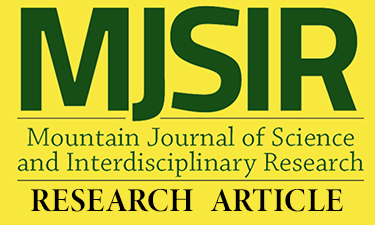Water Yield of a Fog Harvester as Affected by Mesh Material and its Orientation
Main Article Content
Abstract
To compliment the water shortages experienced by farmers during the dry season (November to April) for irrigation and application of chemicals, a fog harvester was constructed at the College of Engineering and Applied Technology in Benguet State University and installed in Sinipsip, Buguias, Benguet. The study analyzed the effect of two mesh materials (i.e., polyethylene mesh SAGN 60% shading and aluminum mosquito mesh) and orientation (i.e., portrait and landscape) on the water yield of the constructed fog harvester. Findings showed that the aluminum mosquito mesh has higher yield of water as compared to the polyethylene mesh, but the treatment mesh material has no significant effect on the water yield of a fog harvester. In terms of orientation, the portrait orientation has collected more water than the landscape orientation, and it has significantly affected the water yield of a fog harvester. Of its cost analysis, the treatment polyethylene mesh in portrait orientation has the highest return of investment of 50.5% while the treatment aluminum mosquito mesh in its landscape orientation has the lowest return of investment of 29.44%. Therefore, the best treatment is the structure with polyethylene mesh in portrait orientation.
Article Details
References
Rosenblatt, S. (2011, June 21). Data Collection Tools. Retrieved from https://alaworkshopdata.wordpress.com/data-collection-tools/
Doble, M., Carino, J., & Abansi, C. (2015). Congress Proceedings: Papers, posters and presentations. Retrieved from https://www.iwra.org/member/index.php?page=286&abstract_id=2746
De Guzman, R. N., & Grospe, R. T. (n.d.). Natural Cloud Water Harvesting for Mountain Agriculture. Retrieved from http://www.eng.warwick.ac.uk/ircsa/pdf/6th/251_guzman.pdf
FAO for Crop Water Needs. (n.d) Retrieved from http://www.fao.org/docrep/S2022E/s2022e07.htm
Guquib, E. (2012, January 21). Sablan-Benguet: Surviving the Threats of Thick Fog. Retrieved from http://www.edmaration.com/2012/01/sablanbenguet-
surviving-threats-of.html
Lapniten, K. S. (2015, April 24). Drought takes toll on Benguet farms. Retrieved from https://www.rappler.com/nation/91025-drought-toll-benguetfarms
Munich re Foundation (n.d.) and Schemenauer & Cereceda, (1997). Fog Drip. Retrieved from http://www.sswm.info/content/fog-drip
Non-Traditional Events and Trends-Buguias- Benguet. (n.d.). Retrieved from http://www.benguet.gov.ph/index.php/11-municipalities/375-non-traditional-events-and-trends-buguias
Peña, R. (2013, September 12). Fog Harvesting.Retrieved from https://www.sunstar.com.ph/article/304641
RSSOCAR (2015). Regional Agricultural Situation Report: January 2015. Retrieved from: htttp://rssocar.psa.gov.ph/agri_situation/regionalagricultural-situation-report-january-2015
Schemenauer, R. S., & Cereceda, P. (1994). A Proposed Standard Fog Collector for Use in High-Elevation Regions. Journal of Applied Meteorology, 33(11): 1313-1322.doi:10.1175/1520-0450(1994)0332.0.co;2
Schemenauer, R. S., & Cereceda, P. (1994). Fog collections role in water planning for developing countries. Natural Resources Forum, 18 (2), 91-100.doi:10.1111/j.1477-8947.1994.tb00879.x
Shanyengana, E. S., Sanderson, R. D., Seely, M. K., & Schemenauer, R. S. (2003). Testing greenhouse shade nets in collection of fog for water supply. Journal of Water Supply: Research and Technology-Aqua, 52 (3), 237-241. doi:10.2166/aqua.2003.0023
Vernall, D. G. (1961). A study of the size and shape of cross sections of hair from four races of men. American Journal of Physical Anthropology, 19 (4), 345-350. doi:10.1002/ajpa.1330190405
Walmsley, J. L., Schemenauer, R. S., & Bridgman, H. A. (1996). A Method for Estimating the Hydrologic Input from Fog in Mountainous Terrain. Journal of Applied Meteorology, 35(12), 2237-2249.doi:10.1175/1520-0450(1996)0352.0.co;2

